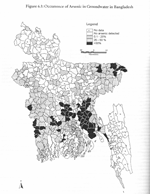|
Draft Development Strategy, National Water Management Plan Arsenic in Annex C, Land & Water ResourcesSection 6 - Water Quality6.3. Arsenic in GroundwaterArsenic in groundwater was identified in Bangladesh in 1993, and a summary of its occurrence and the background issues are set out in Annex C Appendix 8. Previously there had been no policy to test for arsenic, as no problem was suspected. The full extent has yet to be identified but the problem is most strongly concentrated in the South West, South East and North East regions as shown on Figure 6.1, which shows the proportion of tube wells affected in each Thana. Some 20M people are now considered at risk from arsenic in their drinking water. 6.3.1 Preliminary FindingsPreliminary findings indicate:
The three main questions relating to the arsenic problem:
There are no firm answers to these questions at this time, but it is evident that:
The issue of arsenic and the potable water supply is discussed further in Annex L. However, research is urgently needed to improve understanding of the mechanisms involved and the risks, particularly in the context of irrigated agriculture. Farmers are likely to continue to use groundwater in irrigation unless an equally reliable and cheaper alternative becomes available. Should some crops be found to accumulate arsenic then controls on their production will have to be considered. However, this may be difficult to implement in a situation where the arsenic contamination of the water is unevenly distributed. Solutions for the arsenic problem are essential, and options are discussed in Chapters 7 and 8 of the Main Report. 6.3.2.Variation of Quality with DepthIn general, there appears to be an improvement with depth of the borehole. Results from the British Geological Survey of 253 samples showed the following results [click on figure for larger image]. Figure 6.1 - Occurrence of Arsenic in Groundwater in Bangladesh [click on figure for larger image] |

